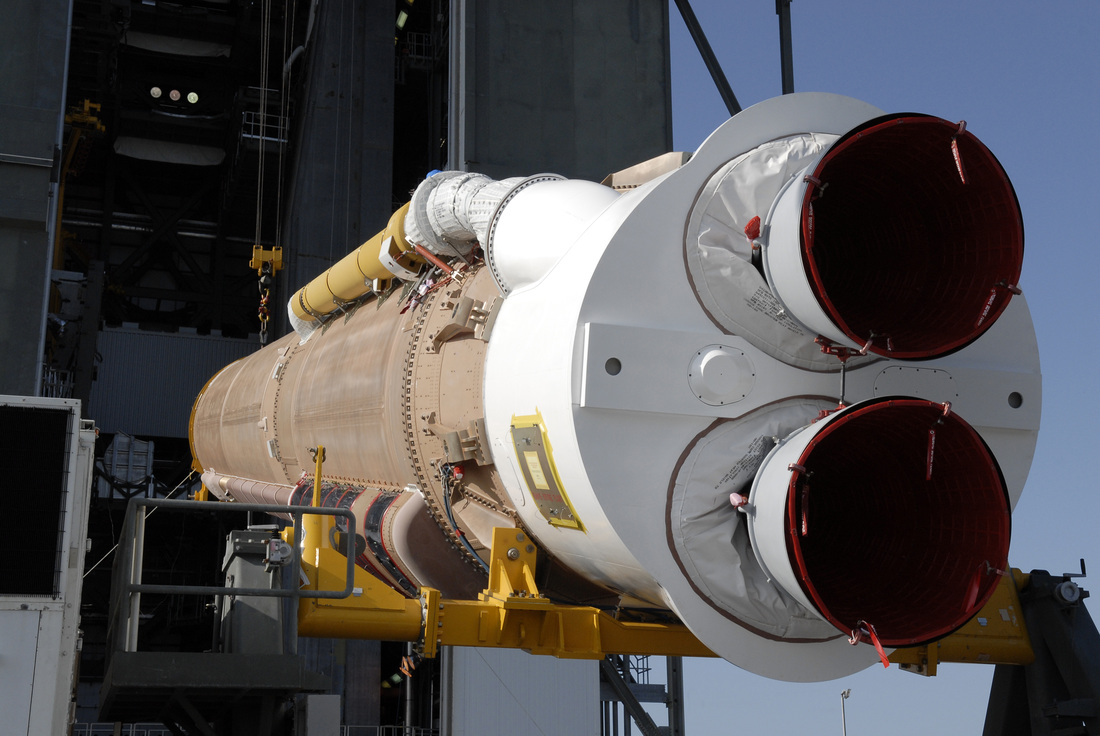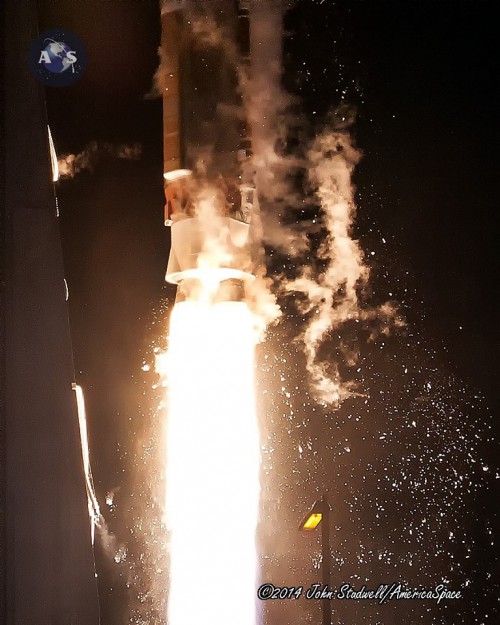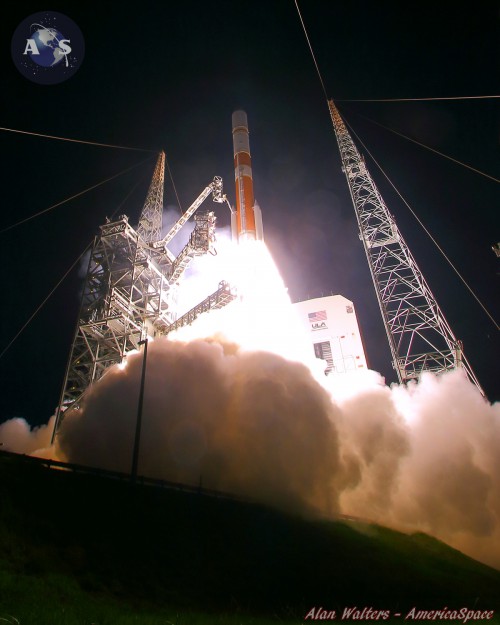
Last August the U.S. Air Force Space and Missile Systems Center issued a Booster Propulsion and Launch System Request for Information (or RFI) for development of a new engine to replace the controversial Russian-made RD-180 engines that currently power ULA’s workhorse Atlas-V rockets, and this week ATK announced their proposal of an American-made commercial solid rocket alternative to the liquid-fueled RD-180 for the Air Force’s consideration.
“ATK’s solid rocket propulsion solution provides a cost-effective, reliable solution based on advanced technology,” said Blake Larson, president of ATK’s Aerospace Group. “By combining our extensive experience with new technologies, we have provided commercial customers with low-cost solutions that progressed from design to flight qualification within months. Using a similar approach, ATK’s propulsion solution will provide the U.S. Air Force with an RD-180 replacement rapidly and at a highly competitive cost.”

ATK already supplies the solid fueled boosters that are needed to give ULA’s larger Atlas-V and Delta-IV rocket variants the extra push they need to deliver larger payloads to space, such as top-secret classified NRO satellites and NASA’s armada of spacecraft that are currently exploring other worlds across the Solar System.
Although the RD-180 engines that currently power ULA’s Atlas-V rocket fleet toward space have proven themselves incredibly reliable time and time again, declining relations with Russia following the country’s annexation of Crimea, and consistent threats toward the Ukraine have forced the United States to second guess the future availability of the RD-180. The engines, which are produced by NPO Energomash of Khimki, Russia, and imported by RD-Amross, a joint venture between Energomash and United Technologies Corp., launch some of America’s most critical national security assets, and so if Russia wanted to stop supplying the RD-180 the United States would be in serious trouble with figuring out how to launch those high-priority Dept. of Defense payloads.
Elon Musk, the president and CEO of SpaceX (ULA’s main competitor), may have said it best on March 5 during a hearing on National Security Space Launch Programs before the U.S. Senate Appropriations Subcommittee on Defense: “In light of recent events in Russia the Atlas-V cannot possibly be described as providing ‘assured access to space’ for our nation when supply of the main engine depends on President Putin’s permission.”
Current estimates suggest a whopping $5 billion loss if ULA were to lose supply of the RD-180 today—costs associated with switching payloads to fly on ULA’s other workhorse rocket the Delta-IV (ULA has already started work to ramp up Delta-IV production, just in case). The Delta-IV is also more expensive to produce, and in the event that ULA lost the Atlas-V the Delta-IV program would have to pick up the slack, which would force payloads already scheduled to fly on the Atlas to launch three to four years later than expected.
As it stands now ULA is in no short supply of the RD-180 engines, but the current Altas-V manifest calls for more than twice as many flights than ULA has RD-180 engines stockpiled to support (15 engines). A pair were delivered to ULA’s Decatur, Ala., assembly facility last August, and three more are expected to arrive next month, with Energomash expected to ship eight RD-180 engines a year between 2015 and 2017. However, the Air Force is not taking any more chances, and so efforts have been moving forward all summer to seek a domestic-made RD-180 alternative and severing America’s dependence on Russia for engines that deliver high security assets to orbit.

Over the past seven years, ATK has incorporated new technologies that have led to innovative design improvements with solid rocket motors, which has resulted in higher performance, increased reliability and affordability, and has led to the development of six new solid rocket motors—some developed in less than two years. To date ATK has provided more than 1,900 commercial and more than 14,000 government solid rocket motors and integrated stages to America’s spaceflight efforts, all domestically built, too.
“We recognize and congratulate the Air Force and ULA on their tremendous launch record,” said Larson. “We are pleased to offer this solution to provide low-cost assured access for current and future National Security Space launch requirements. I am confident our solution will meet the capabilities of the current RD-180 engine and provide added performance if required.”
ATK has not yet released any real details about their RD-180 solid propulsion alternative, but the company has said they will manufacture and test the engine design on American soil, using tooling and infrastructure already in place across the country.
The company is not alone in offering the U.S. government alternative domestic solutions to the Atlas-V RD-180 engine either. Last June ULA itself announced their intention to invest in the development and production of a domestic RD-180 alternative, and America’s most experienced and reliable launch service provider recently announced a new partnership with the Blue Origin aerospace company—privately owned by billionaire and Amazon.com founder Jeff Bezos—to jointly fund the development of a powerful new American-made liquid-fueled rocket engine called the BE-4.
ATK provided NASA with the incredibly powerful solid rocket boosters which launched the now retired space shuttles and their crews to orbit, and the company recently completed the Critical Design Review (CDR) for the boosters that will help launch NASA’s deep space heavy lift Space Launch System (SLS) rocket. Those boosters will be the largest human-rated solid rocket motors ever to fly, and ATK is preparing for a full-scale ground static firing of the booster, Qualification Motor-1 (QM-1), planned for late this year/early next year at ATK’s facility in Promontory, Utah, with the first launch of NASA’s mammoth SLS rocket expected to fly with ATK’s giant boosters for it’s first mission no later than 2018.
Want to keep up-to-date with all things space? Be sure to “Like” AmericaSpace on Facebook and follow us on Twitter: @AmericaSpace




Picture caption on opening page:
“Twin Russian-made RD-180 engines recently lofted the secretive CLIO mission to orbit for the U.S. Government atop a ULA Atlas-V rocket. Photo Credit: John Studwell / AmericaSpace”
Error: Atlas V uses a SINGLE RD-180 engine, consisting of two nozzles, two combustion chambers and ONE turbopump. Should read, “A Russian-made RD-180 engine recently lofted…”